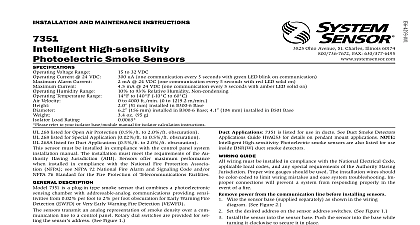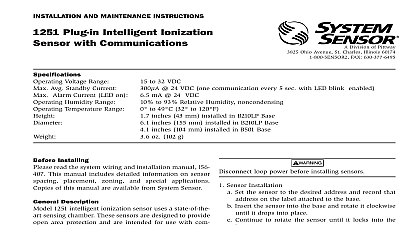System Sensor 3251 Manual

File Preview
Click below to download for free
Click below to download for free
File Data
| Name | system-sensor-3251-manual-5176089342.pdf |
|---|---|
| Type | |
| Size | 652.16 KB |
| Downloads |
Text Preview
INSTALLATION AND MAINTENANCE INSTRUCTIONS Intelligent Ionization Photoelectronic Fixed Temperature 135 Thermal Sensor Voltage Range Standby Current Sensor Humidity Range Temperature Range to 28 VDC 24 VDC no communication F Fixed Temperature Electronic Thermistor to 93 Relative Humidity noncondensing to 38 C 32 to 100 F inches 43mm installed in B210LP base inches 155mm installed in B210LP base inches 104mm installed in B501 base oz 102 g 3825 Ohio Avenue St Charles Illinois 60174 FAX 630 377 6495 Installing sensor must be installed in compliance with the control panel system manual The installation must meet the requirements of the Having Jurisdiction AHJ Sensors offer maximum performance installed in compliance with the National Fire Protection Associa NFPA see NFPA 72 Please read System Sensor Guide for Proper of System Smoke Detectors I56 407 available at no charge from Sys Sensor This manual includes detailed information on sensor spacing zoning and special applications This manual should be left with the owner user of this equip This detector must be tested and maintained regularly fol NFPA 72 requirements The detector should be cleaned at least a year Description Model 3251 intelligent smoke detector is a microprocessor based sen which uses a combination of ionization photoelectric and fixed tem 135 F thermal sensors to detect a wider range of fires than the single sensor smoke detector Rotary decade switches are pro for setting the sensor address see figure 2 This sensor is designed provide open area protection and is intended for use with compatible panels only sensor is provided with two bicolor LED which indicate sensor sta Flashing green indicates normal operation and steady red indicates Remote LED annunciator capability is also available as an optional Model RA400Z Sensor recommends spacing sensors in compliance with NFPA 72 low air flow applications with smooth ceilings space sensors 30 feet For specific information regarding sensor spacing placement and applications refer to NFPA 72 or System Sensor Guide For Proper of System Smoke Detectors Instructions wiring must be installed in compliance with the National Electric Code applicable local codes and any special requirements of the Au Having Jurisdiction AHJ Proper wire gauges should be used installation wires should be color coded to limit wiring mistakes and system troubleshooting connections will prevent a system from responding properly in event of a fire power from the communcation line before installing sensors Wire the sensor base supplied separately per the wiring diagram see 1 Set the desired address on the sensor address switches see figure 2 Install the sensor in the sensor base Push the sensor into the base turning it clockwise to secure it in place After all sensors have been installed apply power to the control unit activate the communication line Test the sensor s as described in the TESTING section of this manual covers provide limited protection against airborne dust particles dur shipment Dust covers must be removed before the sensors can sense Remove sensors prior to heavy remodeling or construction testing notify the proper authorities that the system is undergoing and will be temporarily out of service Also disable the sys to prevent unwanted alarms All sensors must be tested after installa and periodically thereafter Testing methods must satisfy the Having Jurisdiction AHJ Sensors offer maximum performance tested and maintained in compliance with NFPA 72 sensor can be tested in the following ways Functional Magnet Test Model M02 04 01 sensor can be functionally tested using a test magnet The test electronically simulates smoke in the sensing chamber testing sensor electronics and connections to the control panel Hold the test magnet in the magnet test area as shown see figure 3 The sensor should alarm the panel LED on the sensor are controlled by the panel to indicate status Refer to the control panel technical documentation sensor LED status operation and expected delay to alarm Sensitivity Test sensor contains an internal test which continually checks the sen of the sensor If the sensor moves out of its intended sensitivity the sensor will transmit a trouble signal to the control panel Smoke Entry Aerosol Generator Gemini 501 GEMINI model 501 aerosol generator can be used for smoke entry Set the generator to represent 4 ft to 5 ft obscuration as in the GEMINI 501 manual Using the bowl shaped applica apply aerosol until the panel alarms 1 Wiring diagram ANNUNCIATOR 2 Rotary decade address switch RETURN LOOP 5 5 Direct Heat Method Hair Dryer of 1000 1500 watts 3 Test magnet position hair dryer of 1000 1500 watts should be used to test the thermistors the heat toward either of the two thermistors see figure 4 the heat source approximately 12 inches from the detector in to avoid damaging the plastic housing The detector will reset after it has had sufficient time to cool Make sure both ther are tested individually smoke and heat detection testing are recommended for verifying sys protection capability sensor that fails any of these tests should be cleaned as described under and retested If the sensor fails after cleaning it must be re and returned for repair When testing is complete restore the sys to normal operation and notify the proper authorities that the system back in operation cleaning notify the proper authorities that the system is undergo maintenance and will be temporarily out of service Disable the sys to prevent unwanted alarms Remove the sensor to be cleaned from the system Remove the sensor cover using a small standard screwdriver to release of the four cover removal tabs that hold the cover in place Use to avoid damaging the thermistors Vacuum the outside of the screen without removing it Remove the outer chamber assembly being careful not to damage the Pull the assembly straight away from the sensing chamber it snaps out of place Use a vacuum or clean compressed air to the inside of the outer chamber assembly Use a vacuum or clean compressed air to remove dust and debris from sensing chamber Reinstall the outer chamber assembly Align the arrow on the outer assembly with the arrow on the printed circuit board Push outer chamber assembly over the sensing chamber until it snaps place Check to make sure that the screen is in the screen contact Reinstall the sensor cover Use the thermistors and LED to align the with the sensor Snap the cover into place Check to make sure thermistors are in the upright position Reinstall the sensor When all the sensors have been cleaned restore system operation for purposes and test the sensor s as described in the TESTING of this manual STATUS TEST 4 Thermistor positions REMOVAL CHAMBER Limitations of Property Protection Smoke Detectors smoke detector used with this base is designed to activate and initiate emergency but will do so only when it is used in conjunction with an authorized fire alarm This detector must be installed in accordance with NFPA standard 72 detectors will not work without power AC or DC powered smoke detectors not work if the power supply is cut off detectors will not sense fires which start where smoke does not reach the Smoldering fires typically do not generate a lot of heat which is needed to the smoke up to the ceiling where the smoke detector is usually located For reason there may be large delays in detecting a smoldering fire with either an type detector or a photoelectric type detector Either one of them may only after flaming has initiated which will generate the heat needed to drive smoke to the ceiling from fires in chimneys in walls on roofs or on the other side of a close


